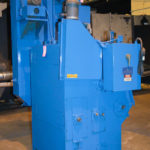Wheel Blasting
Microfinish has continued to expand our extensive metalworking lines with all-new St. Louis wheel blasting services.
In addition to our hand-blasting cabinets and barrel blasting units in which we blast with glass beads, aluminum oxide and ceramic blast medias, we are proud to offer wheel blasting at our St. Louis-based facilities.
What is Wheel-blasting?
Briefly, a spinning wheel takes centrifugal energy to accelerate abrasives such as steel shot or grit to part blasting. With our own in-house Wheelabrator, Microfinish can efficiently and economically remove rust, scale, and carbon on metal surfaces. Wheel blasting is used in the automotive, medical, foundry, and casting industries. In even simpler terms, a spinning wheel shoots an abrasive material such as steel shot at metal parts that need to be stripped of whatever is coating the parts.
A popular way to wheel-blast small parts is to load then into a machine called a Wheelabrator and set it to run for a predetermined period of time.
Why Wheel-blasting?
Wheel blasting is an efficient method for cleaning large parts or large areas of parts to improve the adhesion of coats of color through e-coating, powder coating or other applied coatings. A common reason to wheel blast is to remove rust, and wheel blasting does this quickly and efficiently. Wheel-blasting is a great choice for large parts or large areas of parts:
- Derusted
- Descaled
- Deburred
- Desanded
- Cleaned
This process increases the surface profile of metal parts improving the adhesion of e-coating, powder and other applied coatings.
Additional Wheel-blasting Benefits
Wheel-blasting provides a uniform finish to various casting techniques to hide defects in diecast mold, as well as grind marks, parting lines, and other defects. It can also be used to strip applied coating so parts can be reworked, which means you can salvage parts that otherwise might need to be scrapped. Once the wheel blasting is complete, we can apply rust preventatives to the cleaned parts at your request.
Need to see it to believe it? Check out the example below of a side-by-side before-and-after part that has gone through our St. Louis wheelabrator.

History of Wheel Blasting
Abrasive blasting, or using an abrasive material on parts, has been around for more than a century. Benjamin Chew Tilghman patented the first abrasive blasting process in England in 1869 or 1870 (sources differ on the date). In 1893, a patent for the first blast wheel was filed in Germany. However, a patent for the same thing, a blast wheel, called a Wheelabrator this time, also was filed in the U.S. in 1933 by American Foundry, probably because they didn’t know about the German patent. From there, the underlying technology hasn’t changed but several improvements have been made to wheel blasting since then.












